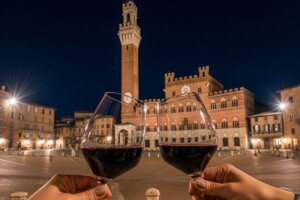In the United States, Italian wine is growing in a big way: over 1 billion dollars worth of exports in 2006, 22 million bottles, 2 million hectoliters of wine, Italy surpasses France for most exports with 34-5% of total foreign wine sales on the U.S. market, and 30.7% of total volume. And WineNews has tried to uncover the reasons for this new found success with the help of Lucio Caputo, president of the Italian Wine & Food Institute.
Lucio Caputo (68, born in Sicily, graduated in journalism from the University of Palermo, two Doctorate degrees in law and political science, and a career at the Italian Trade Commission, ICE, where he was trade commissioner of New York (1970 to 1982), and is today president of the Italian Wine & Food Institute. Caputo remembered that, "in 1975, when I was the commissioner for Italian trade in New York, Italy sold just 4 million bottles of wine in the U.S. (360,000 hectoliters), for a total value of 40 million dollars. And before this, the most sold Italian wines were mainly flasks of Chianti, Verdicchio and Bolla di Soave, Bardolino a Valpolicella, which were among the first wines to be heavily publicized on American television. Lambrusco was at the beginning of its sales, but in the end it reached an annual sale of 14 million bottles".
Many wine sector professionals give merit to Lucio Caputo for the increase in Italian wine sales over this period. "Caputo has gotten Italian wines known" - explained Laura Maioglio, owner of the century-old Barbetta restaurant in New York - "just as was done with the fashion world. Both have now come to dominate French wine and fashion and it was an incredible success. Italian wine has turned into the thing to drink".
Caputo, as commercial commissioner, opened an elegant Italian Wine Center in 1981, designed by architect Piero Sartogo, and then began to heavily promote Italian wines with advertising on all means of communication, informational tours, and visits from some of the most important Italian wine producers. In 1983, Italian wine exports had risen to 26.7 million bottles (2.4 million hectoliters) for a total value of 243 million dollars.
The efforts of the Italian Wine & Food Institute (which was created in 1984 to promote Italian products in the United States, with head office now in Midtown Manhattan, but originally located in one of the Twin Towers before September 11, 2001), were sustained by nutritional studies that proved a Mediterranean diet was good for the health of Americans, including Italian red wine.
Today, Lucio Caputo and the Italian Wine & Food Institute have become fundamental as an institution and for their annual gala held at the New York Marriot Marquis, where all Italian wine producers participate, offering hundreds of samples of new products to buyers, importers, writers, and Italian wine enthusiasts.
"But the report on exports should encourage everyone", explained Lucio Caputo. It has demonstrated that wine exports from Italy have doubled those of France, and quadrupled those of Chile, and a good 7 times that of Spain."The average price for wholesale Italian wine – declared Caputo – was 1 dollar per liter in 1982, and is now 4.83 dollars. California and France are selling at double the price, therefore quality and price are significant factors. Even though the euro has caused a 30% increase in prices for American consumers, when a 12 dollar bottle of wine is acquired, its quality is much higher than that compared to wines from other countries…".
But the competition is fierce. And all of this is occurring at a time when Italians are drinking less wine than ever: "back in the 1970’s, Italians consumed 120 liters per person – noted again Caputo – now they only drink 60-70 liters per person, but do drink better wines". Fortunately for the industry, wine consumption is increasing in the United States. But Caputo believes that competition is fiercer than ever there because technology has now made it easier than ever to produce quality wine products.
"Today, it is very difficult to make a bad wine, thus the quality of low and medium priced wines has increased so much so that consumers can not currently understand the difference between 15 dollar and 50 dollar bottle of wine. There are Italian wines like Nero d'Avola which are sold at 6 dollars per bottle and are incredibly good".
Caputo is resolute in telling Italian producers to keep a line on prices because, "if they don’t do it they will lose the advantage". He points out how Australian wine wholesalers have managed to greatly reduce the sales of mid range wines from California and France. Caputo believes, as well, that China will become an enormous market: "right now they are starting to order wholesale wines, but it is a sector with rapid growth and with a lot of money to spend, and they will spend it on the best and most expensive wines that Italy has to offer".
Using a favorite Italian metaphor, Caputo summarized it all by stating that, "wines are like cars: today you can buy a good car for 12,000 dollars. If you buy a Ferrari or Maserati, you will have more power and accessories, but you will also be paying for the name. Now, Italian wines have the right price to obtain much, much more of the world market".
Fonte: Bloomberg
Copyright © 2000/2025
Contatti: info@winenews.it
Seguici anche su Twitter: @WineNewsIt
Seguici anche su Facebook: @winenewsit
Questo articolo è tratto dall'archivio di WineNews - Tutti i diritti riservati - Copyright © 2000/2025








































































































































































































